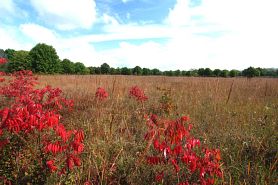Woodman Lake Sand Prairie And Dead Lake
No. 251
 Photo by Thomas A. Meyer/DNR
Photo by Thomas A. Meyer/DNR
Woodman Sand Prairie and Dead Lake feature a dry sand prairie and sand barrens with several blowouts and dunes and Dead Lake, a shallow, seepage lake. The 17-acre lake has a maximum depth of only three feet and is considered to be a deep marsh wetland with excellent habitat for muskrats, beaver, mink, and puddle ducks. In the sand prairie and barrens, dominant vegetation includes big blue-stem, few-flowered panic grass, Muhlenberg's bracted sedge, rough false pennyroyal, Virginia dwarf-dandelion, and wormwood. Lichens and mosses are abundant and include such species as British soldiers and reindeer lichens (Cladonia). Also present are white wild indigo, American figwort, racemed milkwort, whorled milkweed, flowering spurge, and round-headed bush-clover.
Several blowouts and smaller dunes are present with the larger blowouts being stabilized by false heather and dwarf spike moss. The northwest portion of the area is of special interest due to the proximity of the rich Dead Lake Marsh. The marsh edge is quite dramatic as it grades rapidly from a wetland dominated by steeplebush and sedges to a sand blow all within a few feet. The big sand tiger beetle is also found here. Woodman Sand Prairie and Dead Lake is owned by the DNR and was designated a State Natural Area in 1991.
Very few State Natural Areas have public facilities, but nearly all are open for various recreational activities as indicated below. Generally, there are no picnic areas, restrooms, or other developments. Parking lots or designated parking areas are noted on individual SNA pages and maps. Trails, if present, are typically undesignated footpaths. If a developed trail is present, it will normally be noted on the SNA map and/or under the Maps tab. A compass and topographic map or a GPS unit are useful tools for exploring larger, isolated SNAs.
The excellent majority of SNAs are isolated and have few or no facilities. Some SNAs have vehicle access lanes or parking lots, but their accessibility may vary depending on weather conditions. Parking lots and lanes are not plowed during winter. Hiking trails may be nonexistent or consist of undeveloped footpaths. A GPS unit or compass and a detailed topographic map are useful tools for exploring larger SNAs.
Entrance fees: Except for Parfrey's Glen, the Cambrian Outlook in the Dells of the Wisconsin River, SNAs within State Parks and some within State Forests, all other DNR-owned SNAs do not have any admission fees. For more information, see Wis. Admin. Code NR 45 [exit DNR]. For non-DNR-owned SNAs, we are unaware of any vehicle or admission fees. However, please contact the landowner for more information.
ALLOWABLE ACTIVITIES: DNR-OWNED LAND
The activities listed below are generally allowed on all DNR-owned SNA lands. Exceptions to this list of public uses, such as SNAs closed to hunting, are noted above and posted with signs on the property site.
- Hiking
- Fishing
- Cross country skiing
- Hunting
- Trapping
- Scientific research (permit required [PDF])
- Outdoor education
- Wild edibles (What is this?)
- Pets (Rules)
- Wildlife viewing
PROHIBITED ACTIVITIES: ALL SNAS
Although a handful of sites allow activities like primitive camping (e.g. Lower Chippewa River on sand bars) or horseback riding (e.g. S. Kettle Moraine), the activities listed below are generally prohibited on DNR-owned SNAs.
- Camping and campfires
- Collecting of animals (other than legally harvested species), non-edible fungi, rocks, minerals, fossils, archaeological artifacts, soil, downed wood, or any other natural material, alive or dead. Collecting for scientific research requires a permit issued by the DNR
- Collecting of plants including seeds, roots or other non-edible parts of herbaceous plants such as wildflowers or grasses
- Drones: Flying-related activities, including the use of drones, hang-gliders and model airplanes, are prohibited. Permission may be issued by the SNA Program for the use of drones for educational or research purposes.
- Geocaching
- Horseback riding
- Rock climbing
- Vehicles, including bicycles, ATVs, aircraft, and snowmobiles except on trails and roadways designated for their use
For rules governing state-owned SNAs and other state lands, please consult Chapter NR 45 Wis. Admin. Code [exit DNR].
Location
Within the Lower Wisconsin State Riverway, Grant County. T7N-R4W, Sections 1, 11, 12. 286 acres.
Driving directions
From the intersection of State Highway 133 and Main Street in Woodman, go northeast on Main Street for 0.5 miles, then north on Woodman Lake Lane for 0.5 miles to the site.
The DNR's state natural areas program is comprised of lands owned by the state, private conservation organizations, municipalities, other governmental agencies, educational institutions and private individuals. While the majority of SNAs are open to the public, access may vary according to individual ownership policies. Public use restrictions may apply due to public safety, or to protect endangered or threatened species or unique natural features. Lands may be temporarily closed due to specific management activities. Users are encouraged to contact the landowner for more specific details.
The data shown on these maps have been obtained from various sources, and are of varying age, reliability, and resolution. The data may contain errors or omissions and should not be interpreted as a legal representation of legal ownership boundaries.
To create your custom map where you can zoom to a specific location, please use the DNR's mapping application.
Woodman Lake Sand Prairie and Dead Lake are owned by: Wisconsin DNR
